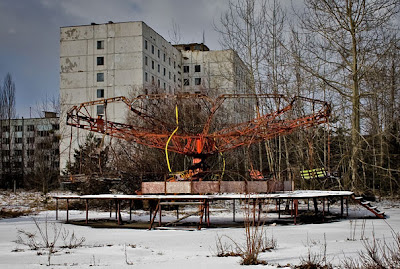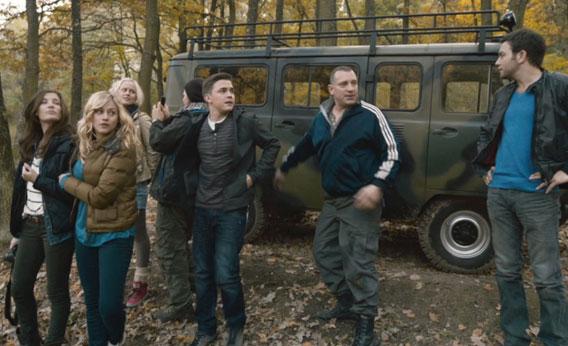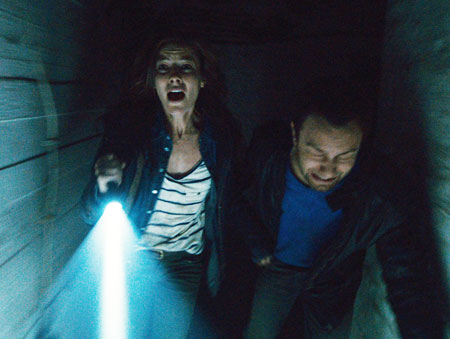Synopsis: Chernobyl Diaries.
So, I'm back with the new post.Synopsis of Chernobyl Diaries Movie. Now Playing at the cinema 25 May 2012.
Director: Bradley Parker
In Theaters: May. 25th 2012 (USA)
Casts:
Jonathan Sadowski as Paul
Jesse McCartney as Chris
Devin Kelley as Amanda
Olivia Taylor Dudley as Natalie
Nathan Phillips as Michael
Ingrid Bolso Berdal as Zoe
Synopsis
An extreme vacation turns terrifying when a group of friends visit the Chernobyl disaster site, and learn that some nightmares never die. Conceived and produced by Paranormal Activity's Oren Peli, Chernobyl Diaries gets underway as six thrill-seeking tourists hire a fearless tour guide, and travel to the abandoned Russian city of Pripyat. Back when the Chernobyl nuclear reactor was up and running, Pripyat was the place the workers called home. But 25 years after one of the worst power-plant accidents in history, the city serves as an eerily silent testament to the dangers of nuclear power. Later, after getting unexpectedly stranded in Pripyat, the tourists and their guide realize they are being hunted. Now the harder they try to flee, the faster their numbers dwindle until only a few are left standing. Only then will the unspeakable terror that stalks these deserted streets finally emerge from the shadows to launch one last relentless, terrifying attack. ~ Jason Buchanan, Rovi
This is not a fiction
Chernobyl failure — destruction on April, 26th, 1986 the fourth power unit of the Chernobyl atomic power station located in territory of Ukraine (at that time Ukraine was a part of Russia). Destruction had explosive character, the reactor has been completely destroyed, and in environment the considerable quantity of radioactive substances has been thrown out. Failure is regarded as the largest in own way for all history of nuclear power, as by prospective quantity of victims and the people who have suffered from its consequences, and on an economic damage. At the moment of Chernobyl NPP failure was the most powerful in the USSR.
Unlike bombardments of Hiroshima and Nagasaki, explosion reminded very powerful «a dirty bomb» — radioactive infection became the basic amazing factor. The radioactive cloud from failure has passed over the European part of the USSR, the Eastern Europe, Scandinavia and even has reached coast of America. The blast wave has rounded globe three times.
Chernobyl Disaster Effect
ontamination from the Chernobyl disaster was not evenly spread across the surrounding countryside, but scattered irregularly depending on weather conditions. Reports from Soviet and Western scientists indicate that Belarus received about 60% of the contamination that fell on the former Soviet Union. A large area in Russia south of Bryansk was also contaminated, as were parts of northwestern Ukraine.
203 people were hospitalized immediately, of whom 31 died (28 of them died from acute radiation exposure). Most of these were fire and rescue workers trying to bring the disaster under control, who were not fully aware of how dangerous the radiation exposure (from the smoke) was (for a discussion of the more important isotopes in fallout see fission products). 135,000 people were evacuated from the area, including 50,000 from the nearby town of Pripyat, Ukraine. Health officials have predicted that over the next 70 years there will be a 2% increase in cancer rates in much of the population which was exposed to the 5–12 EBq (depending on source) of radioactive contamination released from the reactor.
Soviet scientists reported that the Chernobyl Unit 4 reactor contained about 180–190 metric tons of uranium dioxide fuel and fission products. Estimates of the amount of this material that escaped range from 5 to 30 percent, but some liquidators, who have actually been inside the sarcophagus and the reactor shell itself (e.g. Mr. Usatenko and Dr. Karpan) state that not more than 5–10% of the fuel remains inside. Indeed, photographs of the reactor shell show that it is virtually empty.[citation needed] Because of the intense heat of the fire, and with no containment building to stop it, much of the ejected fuel was vaporized or particulized and lofted high into the atmosphere, where it spread.
Suggested long-range effects:
Down syndrome (trisomy 21). In West Berlin, Germany, prevalence of Down syndrome (trisomy 21) peaked 9 months following the main fallout.[ 11, 12] Between 1980 and 1986, the birth prevalence of Down syndrome was quite stable (i.e., 1.35–1.59 per 1,000 live births [27–31 cases]). In 1987, 46 cases were diagnosed (prevalence = 2.11 per 1,000 live births).
Chromosomal aberrations. Reports of structural chromosome aberrations in people exposed to fallout in Belarus and other parts of the former Soviet Union, Austria, and Germany argue against a simple dose-response relationship between degree of exposure and incidence of aberrations. These findings are relevant because a close relationship exists between chromosome changes and congenital malformations.
Neural tube defects (NTDs) in Turkey. During the embryonic phase of fetal development, the neural tube differentiates into the brain and spinal cord (i.e., collectively forming the central nervous system). Chemical or physical interactions with this process can cause NTDs.
Chernobyl Now
 |
| The Corridor of Apartment |
 |
| The Apartement |
 |
| Children's Playground |
 |
| The Shipyard |
More Photos from Chernobyl Diaries
 |
| The Casts |
 |
| Preview 1 |
 |
| Review 2 |
 |
| Review 3 |
To get more information about this film click http://chernobyldiaries.warnerbros.com/index.html
On my opinion: Can't wait to watch this film in Indonesia asap. although this film has bad rating (it's only 1.5 stars) but this film serving us the screenview about chernobyl today. About the disaster who had been claimed many victims and the horror side of this nuclear reactor. thanks :)
Sources:
www.kaskus.us
www.wikipedia.com
www.google.com/images

Comments
Post a Comment